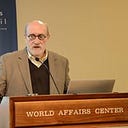They were Europe’s most effective anti-Nazi resistance
Millions of words have been published in English about the French Resistance. Readers, especially American readers, can get the impression that the French effort to resist the Nazis was the best (or even the only one) in Europe. But that’s not true. Underground armies in several other countries formed earlier, became larger, and were far better organized. The Russians, the Yugoslavs, and particularly the Poles mounted impressive operations that tied down hundreds of thousands of German troops for years on end. Doubtless, there are countless books in European languages that tell their stories. But the literature available in English is limited. Historian David J. Williamson’s The Polish Underground, 1939–1947 is the most comprehensive I’ve found. In just 400 pages, he relates the experience of the Polish Resistance throughout the war and in both the German and Russian-occupied zones. Many historians regard it as Europe’s most effective anti-Nazi Resistance.
A STORY OF UNSURPASSED COURAGE AND TRAGIC ENDINGS
Unfortunately, so little about events in Poland has made its way into Americans’ understanding of World War II that many of us confuse or conflate two of the signature events of the period. The two have similar names.
The Warsaw Ghetto Uprising took place in April and May 1943 when 700 Jewish fighters engaged in a heroic but doomed battle against the Nazi campaign to move all the ghetto’s 56,000 remaining inhabitants to the Treblinka death camp and the Majdanek concentration camp.
By contrast, the Warsaw Uprising that unfolded from August through October 1944 was an organized military operation undertaken by Poland’s Home Army. The country’s political and military leadership had planned from the outset to launch a nationwide uprising when it became clear that the Germans were on the retreat and Allied forces entering Poland to support local fighters. However, in Warsaw — alone at first, though later joined by the resistance in other cities — the Home Army’s 50,000-strong local corps rose up believing that the Red Army had reached the suburbs and would come to their aid. For reasons that remain controversial to this day, the Russians did not cross the river into the city as they had promised to do. 15,000 insurgents and 250,000 civilians died as a result. The Germans lost about 16,000 men.
THE POLISH UNDERGROUND, 1939–1947 BY DAVID G. WILLIAMSON (2012) 400 PAGES ★★★★☆
AN HISTORIAN’S ACCOUNT FOCUSED ON POLAND’S MILITARY LEADERSHIP
Don’t pick up this book expecting a breathless account of courageous young soldiers fighting the Nazis against great odds. David Williamson’s story of the Polish resistance is squarely focused on the generals and, to a lesser extent, the Government-in-Exile in London. From the first moments of the Nazi invasion on September 1, 1939, the Polish General Staff began planning the organization of a nationwide insurgent army that would build its strength until the moment when the Germans inevitably began to lose momentum and started their retreat to their own borders. Then the local army would rise up as one and reclaim their country. Of course, from the outset, this plan was a fantasy.
CLASHING EGOS AND OPPOSING POLITICS
Williamson follows the generals’ contradictory plans, fierce political differences, and clashing egos as they set up first one structure for the underground army, then reject it in favor of another. Meanwhile, volunteers on the ground were acting on their own, ignoring orders from London or Warsaw to set up their own, usually small units to resist the Nazis in their own local communities. In the end, however, as the general staff asserted its authority, organized training centers, and smuggled in large quantities of arms and ammunition across the borders, the Home Army emerged as by far the largest and best organized element of the resistance. Two other large operations took shape. The more prominent of these was the Communist “People’s Army” (Armia Ludowa), principally in eastern Poland that the USSR had occupied in September 1939.
A BOOK FOR WWII HISTORY BUFFS, NOT THE GENERAL READER
Polish patriots, military historians, and World War II history buffs will find The Polish Underground, 1939–1947 useful. Williamson relates in great detail the shifting leadership and evolving priorities of Poland’s Government-in-Exile throughout the war. However, neither Williamson or the series editor seems to have intended this book for the general reader. It’s slow going, and the author’s prose is often deadly. Moreover, Williamson’s digression into the operations of the Polish Resistance elsewhere in Europe through Polish expats and forced laborers extended the story into France, Germany, Hungary, Russia, Czechoslovakia, and Romania. Perhaps those activities would have merited a book of their own.
ABOUT THE AUTHOR
David G. Williamson is a British military historian, author, and lecturer. He has written at least 22 books on the history of Germany, the history of diplomacy and international relations, and the military history of the Second World War.
FOR RELATED READING
You’ll find other books about the anti-Nazi underground at 10 true-life accounts of anti-Nazi resistance. For those books specifically about the Polish Resistance, see:
- The Warsaw Uprising, 1 August to 2 October 1944 by George Bruce (The Warsaw Uprising of 1944)
- Poland Alone: Britain, SOE and the Collapse of the Polish Resistance,1944 by Jonathan Walker (The tragic story of the Polish Resistance)
You’ll find books on related topics at:
- 10 top nonfiction books about World War II
- Good books about the Holocaust
- 7 common misconceptions about World War II
- The 10 most consequential events of World War II
And you can always find my most popular reviews, and the most recent ones, on the Home Page of Mal Warwick on Books.
